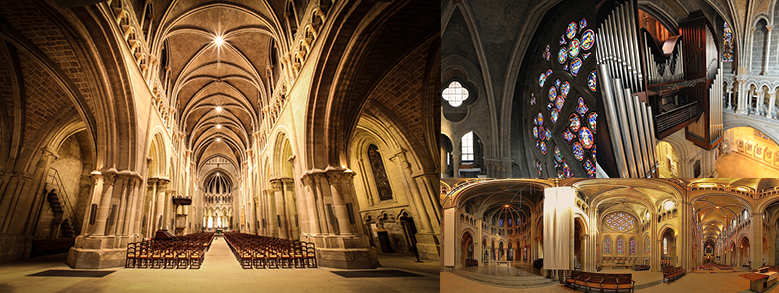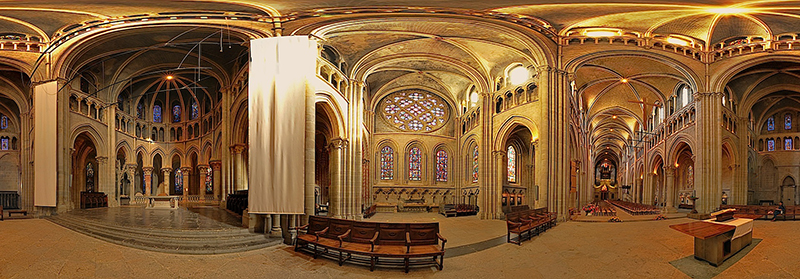The Cathedral of Notre-Dame in Lausanne, Switzerland
The famous Lausanne Cathedral (Cathédrale Notre-Dame) is considered as one of the most beautiful Gothic cathedrals in Europe. It is located approx. 500 ft. above Lake Geneva (Lac Léman) in the hillside city of Lausanne, a city in the french-speaking part of Switzerland (Romandie) and capital of the canton of Vaud. The construction of the cathedral began already in 1175 and it was consecrated in 1275 by Pope Gregory X in the presence of King Rudolf of Habsburg.
The cathedral is topped with towers and spires, and the portals and facade of the cathedral are richly ornamented with carved sculptures and reliefs. The interior is Gothic-style at its most elegant and beautiful, but most decorations were removed in 1536 by the combined forces of the Reformation and Bernese army including altars, statues and paintings. Fortunately, there are some notable exceptions of medieval art that survived until today. One example is the glorious Rose Window located at the south side of the cathedral – a giant Gothic window of stained glass from the 13th century. The rose was a popular medieval representation of the universe and Lausanne’s huge rose contains images representing the four seasons, four elements, four winds, four rivers of paradise, and the twelve labors of the months and signs of the zodiac.
Inaugurated in 2003, the new organ is the only one of its kind in the world: manufactured by the famous American organ builder Fisk and designed by the Italian star designer Giugiaro, the organ’s musical characteristics (French classical and symphonic styles, German baroque and romantic) and its dimensions (nearly 7,000 pipes, 40 tons, 150,000 hours of work to complete) are truly outstanding. Concerts are held on a regular basis, where detailed information on the current program can be found here.
Historical information taken from the official website of Lausanne and Sacred Destinations.

© Photos by Loïc Baboulaz and Dirk Schröder
Room Impulse Response Measurements (Monaural and Binaural)
In a joint project, the Institute for Audiovisual Communications (LCAV) at EPFL, Switzerland, and the Institute of Technical Acoustics (ITA) at RWTH Aachen University, Germany, carried out a huge measurement series of Room Impulse Responses (RIR) in the Cathedral of Lausanne. Using state-of-the-art measurement technology, over 600 RIRs and nearly 90 Binaural RIRs (BRIR), each with a Signal-to-Noise Ratio (SNR) of over 70dB (broadband), were acquired resulting in a dense three-dimensional grid of high quality impulse response measurements over the entire seating area. The complete set of RIRs/BRIRs is currently under review and will soon be available as free download on openMeasurements along with a detailed description of the measurements. The release is scheduled for Autumn 2013. In the meantime, enjoy a small auralization demonstration of measured BRIRs, packaged within a beautiful 360-degree visual tour in- and outside the Cathedral. Please make sure to wear appropriate headphones.
Click on the image below to start the audio-visual tour. Note: large file size, please allow demo to completely load.
Navigation
* Click and drag mouse to change view (or use keyboard arrows).
* Click on grey spheres to jump from one viewpoint to another.
* Click on the grey file symbol to view a still image at the marked position.
* Quick navigation menu by clicking on the small map located at the top left corner.
* In the quick navigation menu, click on the grey triangles to listen to an auralization of the specific position.
* Press ‘a’ to zoom in and ‘z’ to zoom out.
 Click to start the virtual audio-visual tour.
Click to start the virtual audio-visual tour.
Credits
| Measurement Team (LCAV): | Dr. Dirk Schröder, Andreas Walther |
| Measurement Team (ITA): | Dr. Gottfried Behler, Martin Guski, Ingo Witew |
| Visual Panorama Tour: | Dr. Loïc Baboulaz |
| Outdoor Field Recordings: | www.freesound.org |